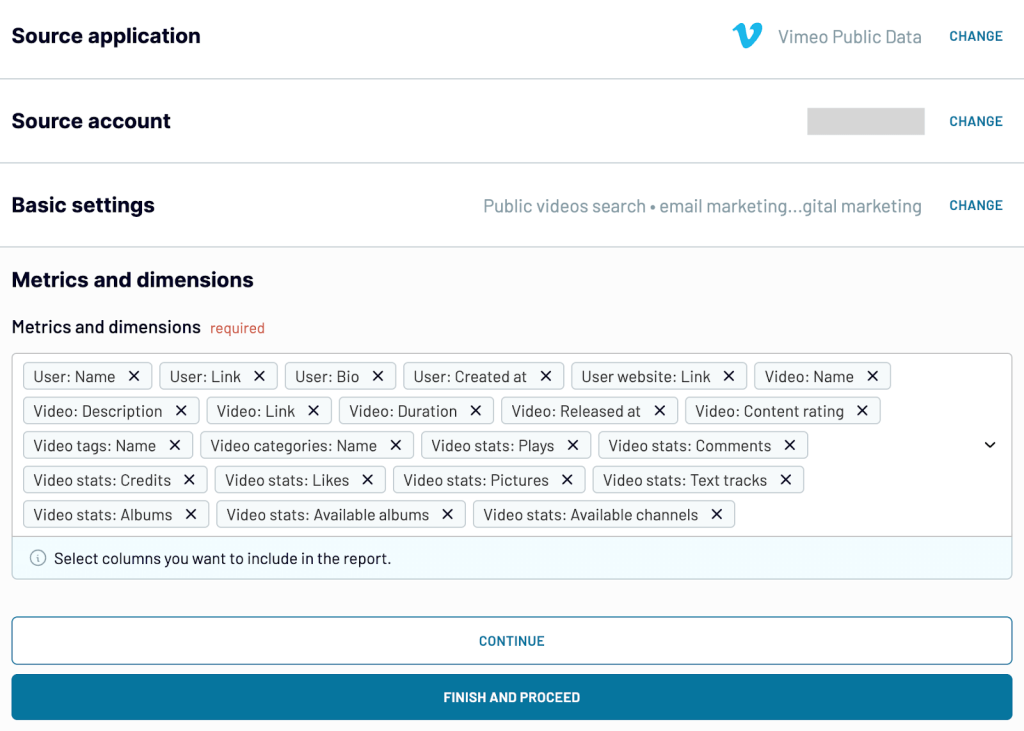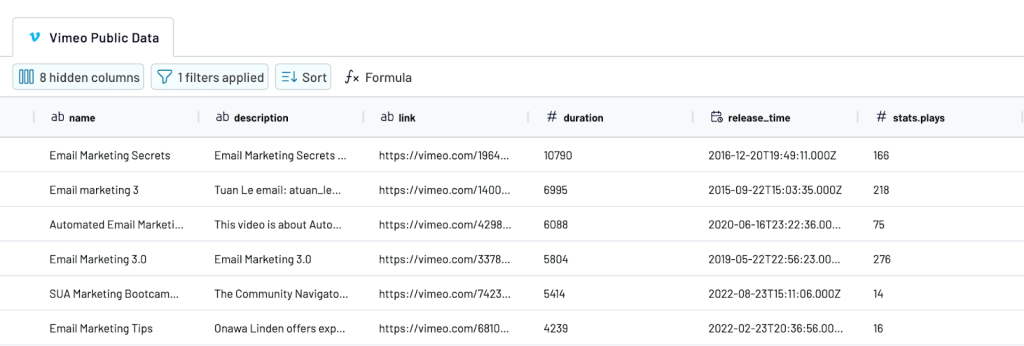Manual export of data from Vimeo is only available for paid members, and it’s quite a time-consuming and repetitive process. So, for reporting, it makes sense to automate data exports to keep your reports up-to-date without any manual effort. Let’s explore how you can do this without any complex setups and configurations.
Methods to export public data from Vimeo
Coupler.io: This reporting automation solution automates the transfer of Vimeo data to spreadsheets, data warehouses, JSON, and BI tools. For example, you can store Vimeo data backup in BigQuery or create reports in Looker Studio for in-depth analysis. Coupler.io allows users to connect Vimeo to the chosen destination in just a few simple steps and schedule data refresh as frequently as every 15 minutes. Moreover, you can combine information from multiple sources since you can export data from YouTube, ad platforms, marketing tools, and more.
Manual download: You can manually download the data of your account videos. But, there is no way to directly download Vimeo public search data. To download your video performance data, go to the ‘Analytics’ tab. At the bottom of any analytics report, you have the option to export your data into a CSV. Any filters applied will be reflected in the exported CSV.
Vimeo API: This method allows you to automate the export of your account videos and public search data. First, obtain an access token through Vimeo. Then, create a script to retrieve data from the API and save it in your preferred format or send it to your desired destination. This method streamlines data transfer but needs technical skills and some initial setup time.
Web scraping: You can use web scraping tools to extract data directly from Vimeo web pages. First, identify the data points you need, such as video titles, descriptions, and views. Write a script to navigate Vimeo pages and extract this information. Now save it in your preferred format, like CSV. This method is highly customizable and flexible but requires programming skills and adherence to Vimeo’s terms of service.
How to set up an automated export of public data from Vimeo on a schedule?
Coupler.io allows you to easily automate the export of Vimeo data in just three steps.
Step 1: Collect Vimeo data
In the form below, we pre-selected Vimeo public data as the source. Choose the desired destination from the drop-down and click on Proceed. Now, create a Coupler.io account for free or log in to your existing account.
Connect your Vimeo account. Configure the source settings and specify the information you want to export.
- Basic settings – Select the report type: My account videos or Public videos search. My account videos report includes detailed metrics and information about the videos uploaded to your Vimeo account. Public videos search report retrieves data on public videos based on specific search keywords to track trends and popular content.
If you choose the latter, add search keywords like ‘email marketing’, ‘digital marketing’, and so on.
- Metrics and dimensions—Review the list of metrics for the selected report type and remove unnecessary ones.

Step 2: Organize and transform data
Once the data is collected, you can organize this data with Coupler.io’s data transformation features.
- Column management: You can add or remove columns to focus on specific metrics, such as release dates, user information, content rating, and more.
- Sort: You can sort videos by metrics such as views or likes to identify top-performing content.
- Filter: You can apply filters to display only videos that meet certain criteria, like those uploaded within the last month.
- Formula columns: You can create custom columns using formulas to calculate metrics like engagement rate (likes + comments/views) for deeper analysis.

Step 3: Load data and schedule transfer
When the data is ready to be exported, follow the in-app instructions to configure the destination settings.
Finally, toggle the Automatic Data Refresh button to receive updated Vimeo data at your desired destination. Specify the schedule, including the interval, days of the week, time preferences, and time zone. You can set the interval to refresh as frequently as every 15 minutes.

Based on your data refresh schedule, Vimeo data will be automatically updated. For example, if you are exporting Vimeo public search data for the keyword ‘email marketing,’ trending videos will automatically update in your chosen destination without any effort. You can use this data in tools like Looker Studio and Power BI to perform trend analysis and come up with a winning content strategy.
What data can be exported from Vimeo by Coupler.io?
Using Coupler.io, you can export comprehensive video data from Vimeo, categorized under two main report types – My account videos and public videos search.
- My account videos: This report provides detailed information about the videos you’ve uploaded to Vimeo. You can see the performance metrics like views, likes, comments, plays, upload dates, and video durations. Use this data to analyze performance and understand how your audience engages with your videos.
- Public videos search: This report lets you export data from public videos on Vimeo based on specific search keywords. You’ll get to see video details like titles, descriptions, tags, video duration, views, content rating, uploader information, and more. You can use this data to identify trends, track popular content, and gain insights into what works well. This is important for the optimization of your videos and experiments. For instance, you can decide if you need to add subtitles in other languages or use captions, choose particular keywords for SEO, experiment with titles and posting time, etc. Eventually, you can come up with a successful content strategy.
The above reports and corresponding metrics can be imported into various destination apps. Let’s now have a look at these different apps.
What are the supported destinations to import Vimeo public data?
With Coupler.io, you can import Vimeo data to multiple destinations, from spreadsheets to BI tools.
- Spreadsheets: Coupler.io supports Google Sheets and Microsoft Excel. You can use these tools to create formulas for analysis or build charts for data visualization.
- Data Warehouses: Supported data warehouses include BigQuery, PostgreSQL, and Redshift. Exporting Vimeo data to these warehouses is ideal if you prefer centralized data storage.
- BI and Reporting Tools: Coupler.io supports business intelligence tools like Looker Studio, Power BI, Tableau, and Qlik Sense. Exporting Vimeo data to these tools helps you conduct in-depth analysis and build interactive reports.
- JSON: You can save Vimeo data as a JSON file for use in various applications that support this format.
- Project Management: Coupler.io also allows you to send data to monday.com, where you can prepare reports like performance and upload schedule reports.
How to visualize public data from Vimeo?
Visualizing Vimeo public data helps you create reports to analyze viewer engagement and content performance. These reports can reveal trends like popular video topics, peak viewing times, audience demographics, and more.
Use Coupler.io to connect Vimeo with powerful tools like Looker Studio, Power BI, and Tableau. As shown in previous sections, start by collecting your Vimeo data and connecting it to the desired BI application.
Once the data is loaded, you can build detailed dashboards to display metrics such as views, likes, comments, and upload dates. The visualizations used in these dashboards will help you understand which videos are performing well, how audiences are engaging with your content, and how to optimize future videos for better results.
For more inspiration on creating effective visualizations, explore our range of dashboard templates designed specifically for these tools.
Automate data export from Vimeo with Coupler.io
Get started for free



